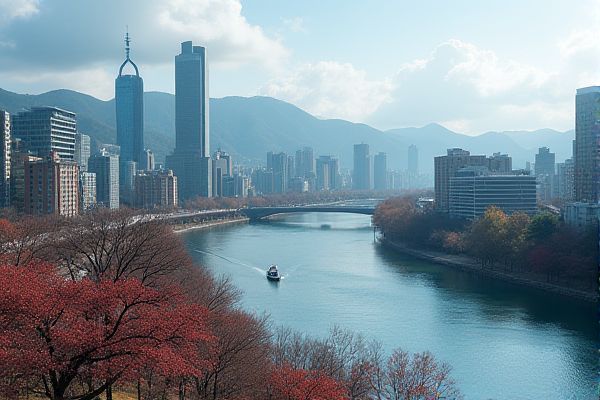
Shopping and retail options in South Korea: Diverse department stores and malls. Traditional markets offer unique experiences. Popular online shopping platforms. Duty-free shopping for tourists. Convenience stores open 24/7. Seasonal sales and discounts. Local and international brand availability. Haggling in market settings. Specialized districts for electronics. Tax refund options for foreigners.
Diverse department stores and malls.
In South Korea, retail options are diverse, with the emergence of large Western-style malls like Starfield Hanam, which offers a vast array of brands, hypermarkets, and entertainment facilities, contrasting with traditional department stores like Shinsegae and Lotte that dominate the market with extensive product ranges and leisure activities. These modern malls are expanding beyond Seoul, catering to changing consumer preferences for advanced and diverse shopping environments.
Traditional markets offer unique experiences.
Traditional markets in South Korea, such as Namdaemun Market and Gwangjang Market, offer unique shopping experiences with a rich history, vibrant atmosphere, and a wide range of products including traditional goods, local specialties, and affordable everyday items. These markets provide a glimpse into Korea's authentic shopping culture, combining centuries-old traditions with modern grocery shopping and cultural activities. For a comprehensive guide to exploring these vibrant marketplaces, you can visit the Best Seoul Street Markets to discover more about these incredible destinations.
Popular online shopping platforms.
In South Korea, the leading online shopping platforms are renowned for their diverse offerings and innovative features. Among these, Coupang, Naver Shopping, SSG.com, Gmarket, and 11st.co.kr stand out as the most frequently visited and popular e-commerce sites, catering to a wide consumer base. These platforms, alongside others such as Lotteimall and Wemakeprice, are celebrated for their unique capabilities like fast delivery, comprehensive search and shopping integration, and a broad selection of products. For instance, Korean E-commerce Platform insights reveal how these sites maintain a strong foothold in the market by continuously adapting to consumer needs and leveraging cutting-edge technology.
Duty-free shopping for tourists.
In South Korea, duty-free shopping for tourists is available at designated duty-free stores, primarily operated by large department store chains like Lotte, Shilla, and Shinsegae, located both in airports and downtown areas. These stores exclude Value Added Tax (VAT) and Individual Consumption Tax from the retail price, providing immediate tax savings to shoppers. Discover more about the exciting world of duty-free shopping at the Visit Korea website for detailed information and guidance on maximizing your shopping experience during your visit.
Convenience stores open 24/7.
Convenience stores in South Korea are open 24/7, offering a wide range of products and services, including food, beverages, hot meals, electronics, and toiletries, making them essential for both locals and tourists. These stores provide a convenient and lively experience, with some even featuring self-cooking facilities and specialty coffee shops. For more information on how to make the most of these stores, you can visit the comprehensive guide available on Koreabybike, which offers insights into the unique services these convenience stores offer.
Seasonal sales and discounts.
In South Korea, significant seasonal sales and discounts are offered during events like the Korea Sale Festa, which runs from November 9 to 30, featuring discounts from over 2,600 companies across various sectors, including automobiles, home appliances, and culture and leisure. This event aims to boost domestic consumption by offering substantial discounts on durable goods and seasonal items.
Local and international brand availability.
In Seoul, shoppers can find a wide range of local and international brands, including popular Korean skincare brands like Etude House and Nature Republic in Myeongdong, as well as international brands in shopping malls like Lotte Mart and underground shopping malls. Additionally, districts like Dongdaemun offer over 20,000 specialty stores with about 50,000 brands, including electronics, clothing, and more. For further insights into the vibrant shopping scene, visit this Shopping In Seoul Guide which provides a comprehensive look at malls, shopping streets, and underground markets.
Haggling in market settings.
Haggling in South Korean market settings is a common and culturally accepted practice, especially in wholesale and traditional markets. To haggle effectively, compare prices, buy in bulk, be polite, and use phrases like "Jogeum-man kkakka juseyo" (Can I get a little discount?) to negotiate lower prices. For more detailed tips and insights on mastering this art, check out this guide on Haggling at Wholesale Markets in Korea.
Specialized districts for electronics.
Yongsan Electronics Market in Seoul stands as the largest electronics hub in South Korea, featuring over 20 buildings with 5,000 stores offering a vast assortment of electronics, including computers, smartphones, gaming consoles, and electronic components, often at prices 20-50% lower than mainstream retail outlets. The market encompasses specialized areas such as Wonhyo Electronic Market for electricity and lighting equipment, Yongsan ETLand for electronic devices and home appliances, and Najin Mall for mobile phones, game consoles, and computer peripherals.
Tax refund options for foreigners.
In South Korea, foreigners can obtain tax refunds through three main methods: duty-free shopping at designated stores where taxes are waived in advance, immediate tax refunds at certified stores where taxes are deducted at the time of purchase, and post-purchase tax refunds where shoppers pay full price and apply for a refund before leaving the country. The post-purchase method requires meeting specific requirements, such as minimum purchase amounts and deadlines for claiming the refund. For more information on how to effectively navigate these processes, you can visit the comprehensive guide on Tax Refunds in Korea which elaborates on each method and provides helpful tips.
